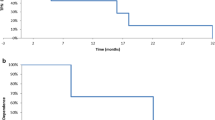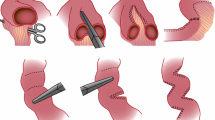Abstract
Background
Currently, there are two well-established methods of bowel lengthening in patients with short bowel syndrome (SBS)-longitudinal intestinal lengthening and tailoring (LILT) and serial transverse enteroplasty (STEP) [1–4]. Both procedures may carry a high reported morbidity and mortality of 30.2% and 14.4%, respectively [5]. We report the outcomes of a novel technique: double barrel enteroplasty (DBE) for autologous intestinal reconstruction.
Methods
We performed a retrospective review of all ten patients who underwent DBE at our institution since 2011. All patients have SBS and were dependent on parenteral nutrition (PN) at the time of surgery. Etiologies were gastroschisis (n = 4), bowel atresia (n = 3), necrotising enterocolitis (n = 1), volvulus (n = 1), and near-total intestinal aganglionosis (n = 1). Patient survival, complications, and subsequent enteral autonomy were evaluated.
Results
All patients are alive with normal liver function. Five children achieved enteral autonomy, while the remaining are on weaning PN. There was no bleeding, anastomotic leak, perforation, infective complications, or intestinal necrosis. No patient has required a liver and/or intestinal transplant.
Conclusions
Double barrel enteroplasty is technically feasible and safe. It has similar efficacy and may have fewer complications when compared with other methods of autologous intestinal reconstruction.




Similar content being viewed by others
References
Sudan D, Thompson J, Botha J (2007) Comparison of intestinal lengthening procedures for patients with short bowel syndrome. Ann Surg 246:593–604
Bianchi A (1980) Intestinal loop lengthening—a technique for increasing small intestinal length. J Pediatr Surg 15(2):145–151
Kim HB, Fauza D, Gasza J et al (2003) Serial transverse enteroplasty (STEP): a novel bowel lengthening procedure. J Pediatr Surg 38(3):425–429
Kim HB, LeePW GJ et al (2003) Serial transverse enteroplasty for short bowel syndrome: a case report. J Pediatr Surg 38(6):881–885
Frongia G, Kessler M, Weih S et al (2013) Comparison of LILT and STEP procedures in children with short bowel syndrome—a systematic review of the literature. J Pediatr Surg 48:1794–1805
Kottra JJ, Dodds WJ (1971) Duplication of the large bowel. Am J Roentgenol 113:310
Aigrain A, Cornet D, Cezard JP (1985) Longitudinal division of small intestine: a surgical possibility for children with very short bowel syndrome. Z Kinderchir 40:233–236
Shah AA, Petrosyan M, Franklin A et al (2019) Autologous intestinal reconstruction a single institution study of serial transverse enteroplasty (STEP) and the longitudinal intestinal lengthening and tailoring (LILT). Pediatr Surg Int. https://doi.org/10.1007/S00383-019-04468-3
Kang KH-J, Gutierrez I, Zurakowski D et al (2012) Bowel re-dilation following serial transverse enteroplasty (STEP). Pediatr Surg Int 28:1189–1193
Miyasaka EA, Brown PI, Teitelbaum DH (2011) Redilation of bowel after intestinal lengthening procedures-an indicator for poor outcome. J Pediatr Surg 46:145–149
de Lorimier AA, Harrison MR (1983) Intestinal plication in the treatment of atresia. J Pediatr Surg 18(6):734–737
Lambe C, Poisson C, Rocha A et al (2017) The NPEI/REE Ratio: a new dependency index in paediatric parenteral nutrition? Transplantation 101(6S2):S77
Schofield WN (1985) Predicting basal metabolic rate, new standards and review of previous work. Hum Nutr Clin Nutr 39(Suppl 1):5–41
Barrett M, Demehri FR, Ives GC et al (2017) Taking a STEP back: assessing the outcomes of multiple STEP procedures. J Pediatr Surg 52:69–73
Höllwarth ME (2017) Surgical strategies in short bowel syndrome. Pediatr Surg Int 33:413–419
Goulet O, Nader EA, Pigneur B et al (2019) Short bowel syndrome as the leading cause of intestinal failure in early life: some insights into the management. PGHN 22(4):303–329
Sommovilla J, Warner BW (2014) Surgical options to enhance intestinal function in patients with short bowel syndrome. Curr Opin Pediatr 26:350–355
Stringer MD, Puntis JW (1995) Short bowel syndrome. Arch Dis Child 73:170–173
Fitzgerald K, Muto M, Belza C et al (2019) The evolution of the serial transverse enteroplasty for pediatric short bowel syndrome at a single institution. J Pediatr Surg. https://doi.org/10.1016/j.jpedsurg.2019.01.051
King B, Carlson G, Khalil BA et al (2013) Intestinal bowel lengthening in children with short bowel syndrome: systemic review of the bianchi and STEP procedures. World J Surg 37:694–704. https://doi.org/10.1007/S00268-012-1879-3
Onufer EJ, Czepielewski R, Seiler KM et al (2019) Lymphatic network remodeling after small bowel resection. J Pediatr Surg 54(6):1239–1244
Mutanen A, Barrett M, Feng Y et al (2019) Short bowel mucosal morphology, proliferation and inflammation at first and repeat STEP procedures. J Pediatr Surg 54:511–516
Lobos PA, Calello SEM, Busoni VB et al (2016) Neonatal serial transverse enteroplasty (STEP): case report. Transpl Proc 48(2):528–531 (PMID: 27109993)
Bhalla VK, Pipkin WL, Hatley R et al (2013) The use of multiple serial transverse enteroplasty (STEP) procedures for the management of intestinal atresia and short bowel syndrome. Am Surg 79:826–829
Bianchi A (1984) Intestinal lengthening: an experimental and clinical review. J R Soc Med Suppl 3(77):35–41
Garnett GM, Kang KH, Jaksic T et al (2014) First STEPs: serial transverse enteroplasty as a primary procedure in neonates with congenital short bowel. J Pediatr Surg 49:104–108
Wood SJ, Khalil B, Fusaro F et al (2013) Early structured surgical management plan for neonates with short bowel syndrome may improve outcomes. World J Surg 37(7):1714–1717
Dewberry LC, Hilton SA, Vuille-Dit-Bille R (2020) Is tapering enteroplasty an alternative to resection of dilated bowel in small intestinal atresia. J of Surg Res 246:1–5 (PMID: 31541708)
Acknowledgements
We would like to thank Dr. Yann Polfrit, Pediatrician, Centre Hospitalier Territorial Gaston-Bourret, Noumea, New Caledonia and Dr. Scott Nightingale from the Department of Paediatric Gastroenterology, John Hunter Hospital in Newcastle, NSW, Australia, for follow-up care of patients 1, 2, and 5, respectively. Dr, Gordon Thomas provided the illustrations.
Funding
This research did not receive any grants from any public or private funding agencies.
Author information
Authors and Affiliations
Contributions
All authors participated in the data acquisition, in patient care, and critical revision of the manuscript. The first draft of the manuscript was written in full by Albert Shun and all authors commented on previous versions of the manuscript. All authors read and approved the final manuscript.
Corresponding author
Ethics declarations
Conflict of interest
All authors have no conflicts of interest to declare.
Additional information
Publisher's Note
Springer Nature remains neutral with regard to jurisdictional claims in published maps and institutional affiliations.
Electronic supplementary material
Below is the link to the electronic supplementary material.
Rights and permissions
About this article
Cite this article
Shun, A., Thomas, G., Puppi, J. et al. Double barrel enteroplasty for the management of short bowel syndrome in children. Pediatr Surg Int 37, 169–177 (2021). https://doi.org/10.1007/s00383-020-04767-0
Accepted:
Published:
Issue Date:
DOI: https://doi.org/10.1007/s00383-020-04767-0




